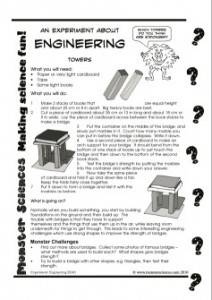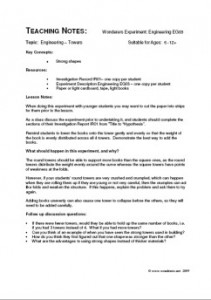Test the strength of different construction techniques in this engineering experiment.
 |
 |
What you will need:
- Paper or very light cardboard
- Tape
- Some light books
What you will do:
- Make 2 stacks of books that are equal height and about 20 cm or 8 in apart. Big heavy books are best.
- Cut a piece of cardboard about 35 cm or 13 in long and about 18 cm or 5 in wide. Lay the piece of cardboard across between the book stacks to make a bridge.
- Put the container on the middle of the bridge, and slowly put marbles in it. Count how many marble you can put in before the bridge collapses. Write it down.
- Use a second piece of cardboard to make an arch support for your bridge. It should bend from the bottom of one stack of books up to just touch the bridge and then down to the bottom of the second book stack..
- Test this bridge’s strength by putting the marbles into the container and write down your answer.
- Now take the same piece of cardboard and fold it up and down like a fan. Keep the folds fairly close together.
- Put it down to form a bridge and test it with the marbles as before.
What is going on?
Normally when you build something, you start by building foundations on the ground and then build up. The trouble with bridges is that they have to support themselves and the things that use them up in the air, while leaving room underneath for things to get through. This leads to some interesting engineering challenges which use strong shapes to improve the strength of bridges.
Monster Challenges:
- Find out more about bridges. Collect some photos of famous bridges – what methods are used to build each? What shapes give bridges strength?
- Try to build a bridge with other shapes, e.g. triangles, then test their strength.
Teaching Notes:
Topic:
Engineering – Towers
Key Concepts:
Strong shapes
Resources:
- Investigation Record IR01– one copy per student
- Experiment Description Engineering EG03 – one copy per student
- Paper or light cardboard, tape, light books
Lesson Notes:
When doing this experiment with younger students you may want to cut the paper into strips for them prior to the lesson.
As a class discuss the experiment prior to undertaking it, and students should complete the sections of their Investigation Report IR01 from ”Title to “Hypothesis”.
Remind students to lower the books onto the tower gently and evenly so that the weight of the book is evenly distributed across all 4 towers. Demonstrate the best way to add the books.
What should happen in this experiment, and why?
The round towers should be able to support more books than the square ones, as the round towers distribute the weight evenly around the curve whereas the square towers have points of weakness at the folds.
However, if your students’ round towers are very crushed and crumpled, which can happen when they are rolling them up if they are young or not very careful, then the crumples can act like folds and weaken the structure. If this happens, explain the problem and ask them to try again.
Adding books unevenly can also cause one tower to collapse before the others, so they will need to be added carefully.
Follow up discussion questions:
- If there were fewer towers, would they be able to hold up the same number of books, i.e. if you had 3 towers instead of 4. What if you had more towers?
- Can you think of an example of when you have seen the strong towers used in building?
- How do you think they first figured out that one shape was stronger than the other?
- What are the advantages to using strong shapes instead of thicker materials?



